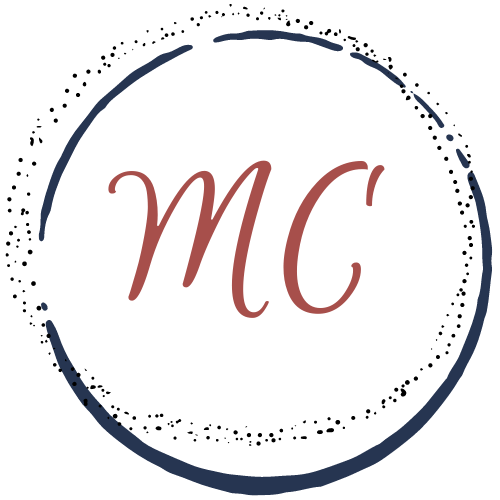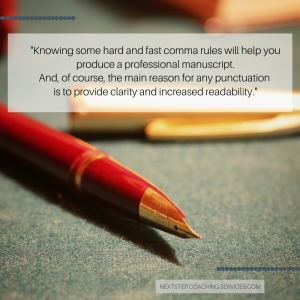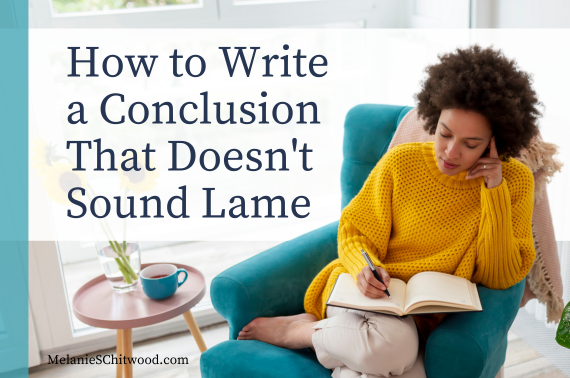How to Use Commas Correctly
Because you can hardly read a paragraph without stumbling on a comma, knowing some hard and fast comma rules will help you to produce a professional manuscript. And, of course, the main reason for any punctuation is to provide clarity and increased readability. Today let’s look at five rules for using commas.
To Separate Words in a List
Using commas to separate words in a list (or series) of three or more is a common comma rule. When you use a comma before the word and as you get to the end of your list, it’s called an Oxford or serial comma and looks like this:
Example: We took a hike, picked apples, and enjoyed a picnic lunch.
I prefer using the Oxford comma, where you always have a comma before the and in a list.
However, note that it is also acceptable not to include that last comma, in other words not to use the Oxford comma. In that case the sentence would read:
We took a hike, picked apples and enjoyed a picnic lunch.
What’s important is that you pick a style and use that style consistently throughout your manuscript.
Introductory Word or Phrase
When your sentence starts with an introductory word or short phrase, use a comma.
Example: On the other hand, I see your point of view.
Example: However, I am sticking with my first answer.
Example: Oh, I didn’t see you there!
To Separate Adjectives
When you use two or more adjectives before a noun, use a comma between them (these are called coordinate adjectives, in case you’re nerdy like me and love knowing things like that!)
Example: Stephanie is a kind, smart girl.
The key to using the comma correctly is that the adjectives describing the noun must be equal in value in order to need a comma. So here’s a little trick to know if they’re equal in value: You can replace the comma with and.
So let’s try this with our example. Let’s take out the comma and replace it with the word and:
Stephanie is a kind and smart girl. Because using and retains the same meaning as when using the comma, then you know you need a comma there. Try another one:
Example: The steep, winding road leads you to the cabin.
Is the comma needed in this sentence? Yes! Steep and winding road makes sense, so you know you need a comma.
Let’s look at one more example:
Example: She uses white, bath towels in all her bathrooms.
Correct or not? Not! No comma needed. How do you know? Replace the comma with and—She uses white and bath towels. That doesn’t make sense, so no comma needed. But if you’re still not sure, try reversing the order of the adjectives—She uses bath and white towels. You wouldn’t say this, so you know a comma is not needed. This is the correct sentence:
She uses white bath towels in all her bathrooms.
Appositives
Don’t let that word scare you! An appositive is a word or phrase that renames the subject. There are two types of appositives—nonrestrictive and restrictive. A nonrestrictive appositive is a phrase that is not necessary and just adds more information. A restrictive appositive is a phrase that is necessary to the sentence.
Example: Amy, the physical therapist who has worked at that location the longest, is my favorite. .
In this sentence the appositive is the physical therapist who has worked at that location the longest and is renaming the subject Amy. It is nonrestrictive, simply adding more information, so the commas are needed.
Let’s look at another example.
Example: One of my favorite authors Rachel Hauck has released a new book.
Correct or not? Correct! The appositive Rachel Hauck is restrictive, meaning it’s necessary to the clarity of the subject so no commas are needed.
With the word too
The word too means in addition or also. It often comes at the end of the sentence.
Example: He likes mint chocolate chip ice cream too.
Most of the time when too is used at the end of the sentence, you do not need to use a comma.
Would it be wrong to use a comma before too in this example? No. If you want to create a pause for emphasis, you could write the sentence like this:
He likes mint chocolate chip ice cream, too.
So the rule about using a comma with too? It depends! If you want to create a pause for emphasis, then use a comma.
If you put the word too in the sentence, you usually are doing so to create emphasis and would need the commas. That sentence would look like this:
Example: He, too, likes mint chocolate chip ice cream.
I hope these rules have helped you! If you want to read more about commas, you’ll find a post here with some additional comma rules.
If you have a specific question about using commas, let me know and I’ll give you an answer!
~Melanie








This is a wonderful reminder! The only thing I disagree with is the Rachel Hauck example. I would absolutely use commas around her name since you can remove her name and it is still a complete sentence — making it, in my opinion, a nonrestrictive appositive. I love this list and will forward it to my kids. Thank you!
Thanks Elizabeth for the feedback! My rule of thumb is not to use commas with appositive that are names, generally speaking. But you did make me want to go do
a little research, so thanks for that!
Yes that’s good info . The way I teach this is to clarify that if a proper name (or noun) comes first (precedes the appositive) then use commas around the appositive because the person (proper noun) has been named first, so we know who ( or what) the sentence is referring to, but if the appositive comes first
(before the proper name/noun) then no commas needed because readers would want to know who/what specifically the appositive is referring to.
Example: When my best friend Leslie visits, we enjoy sharing family stories. (no commas around Leslie)
vs
When Leslie, my best friend, visits, we enjoy sharing family stories. (the detail encased in commas is considered non-essential because Leslie is named first) Hope that makes sense The comma after ‘visits’ is also necessary because this sentence begins with a subordinate clause, which is another more complicated rule for using a comma.
Ahhh, gotta love grammar!!
So informative! Thank you!
Thank you, Toni! It’s nice to know other people like these punctuation and/or grammar posts as much as I like writing them!
Great information!
I’m just wondering why you didn’t include the use of a comma with a conjunction (what I call fanboys) when joining two closely related sentences. This is important to prevent run on and comma splice errors. I’m an English teacher, and I spend a lot of time on this comma rule. much thanks
Yes, Theresa, that is a biggie! I’ve written previous posts that addressed that rule, but it’s been awhile so I’ll add that to my
next post about commas! Thanks!
Yes! I do believe that would qualify a lesson of its own.
That’s excellent! Thank you!!
Melanie, thanks so much for giving such clarity about using commas. I have a team of writers for our online magazine and community RADIANT.NYC https://www.radiant.nyc and I’m going to be sharing the link to this article with them. (I know Amy well so please say hi to her from me.)